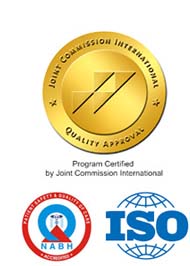Liver transplants in India:
A liver transplant procedure is a very complex surgery that is very professionally done at select hospitals in India with a success rate of 95% for the patient and 100 % safety for the donor. These success rates are on par with the best liver transplant centres internationally. India's leading liver transplant surgeon performs between 16-18 liver transplants every month, perhaps the highest number of liver transplant surgeries led by any single surgeon anywhere in the world.
Anti-Reflux Surgery (Fundoplication) Surgery in India:
This is a surgical procedure for treating gastro-esophageal reflux disease (GERD). GERD is a condition in which acids from the stomach rise up the food pipe towards the throat. This causes pain in the chest region, inflammation as well as scarring and narrowing of the food pipe. The fundoplication procedure involves the coiling of the stomach portion that is closest to the food pipe around the oesophagus and stitching it in place. This coiling of a portion of the stomach around the food pipe creates a barrier to the upward flow of acids from the stomach.
Laparoscopic Cholecystectomy (Gall Bladder Removal Surgery) in India:
Gallbladder removal is most often done when a patient is suffering from gallbladder stones. The only cure for this condition is gall bladder removal surgery. Traditional cholecystectomy required an incision of about 8 inches in the abdomen just below the waist. Across the world, including in hospitals in India, cholecystectomy is now performed most often using the laparoscopic method. Using a laparoscope, the surgeon is able to remove the gallbladder by making just three small incisions rather than one long, invasive incision. The laparoscope consists of a thin flexible tube with a camera mounted on it. The camera produces very clear and magnified images on a big screen. Tiny surgical instruments are inserted through the other small incisions and the removal of the gallbladder is performed through these small cuts. Laparoscopic surgery for gall bladder removal in India leaves very few scars, is much less painful and also enables you to recover much faster from the surgery.
Colostomy Surgery in India:
A colostomy procedure is a surgery which is performed to divert stools away from the rectum into a drain bag placed outside the body. In this surgery one end of the large intestine is brought out through the wall of the abdomen. A colostomy bag is attached to the abdomen. Stools moving through the intestines after digestion are thus diverted away from the rectum into the drain bag. The other end of the large intestine which leads to the rectum is closed off till the desired medical results are achieved. This is a reversible procedure.
Colostomy surgeries are commonly performed at hospitals in India for the following conditions: Infection of the abdomen, Injury to the colon or rectum, intestinal obstruction, etc.
Colostomy surgery is performed under general anaesthesia and can take between 2-5 hours depending on the complexity of the case.
Stapled / Stapler Haemorrhoidectomy ( Surgery for Removal of Haemorrhoids) in India:
Conventional Haemorrhoidectomy is an open surgery to remove painful or prolapsed hemorrhoids. Surgery is performed under general anesthesia or spinal anesthesia. Incisions are made in the tissue around the hemorrhoid and the hemorrhoid is removed. The surgical site may be sutured or left open and full recovery normally takes about three weeks. This traditional treatment for third and fourth degree haemorrhoids is now giving way to the revolutionary Stapler Haemorrhoidectomy in India.
Stapler Haemorrhoidectomy is commonly performed at leading hospitals in India. This new innovation eliminates the necessity to cut and remove the haemorrhoid tissue at the anus. In stapler haemorrhoidectomy, the tissue above (not at the opening of) the anus is removed using a special haemorrhoid stapler. This stapler cuts away loose tissue. Special, microscopic titanium staples are then used to join together the remaining tissue edges. The tissue removal in this procedure happens above the anus, an area where nerve endings are significantly lower, thereby making this procedure far less painful than conventional haemorrhoidectomy, which involves painful external scars near the anus.
Recovery is very quick and the patient is normally able to leave the hospital either the same day or the next day. Complications are quite rare, and the staples fall off on their own without the patient realising it.
Gastrectomy ( Surgery for Removal of the Stomach) in India:
Gastrectomy is a surgical procedure for the removal of the entire stomach (Total Gastrectomy), or a portion of it (Partial Gastrectomy). Gastrectomy surgery is commonly performed in India for the treatment of bleeding gastric ulcers, perforation of the wall of the stomach, noncancerous polyps, stomach cancer, etc.
The surgery is performed under general anaesthesia. If the lower end of the stomach is diseased, the surgeon removes that section. He then attaches the upper part of the stomach to the small intestine. If the upper section of the stomach is removed, the lower portion of the stomach is connected with the esophagus.
Pancreas Transplant Surgery in India:
Pancreas is that organ of the body which produces insulin. The first pancreas transplantation surgery was conducted in 1966.
This procedure involves the implantation of a healthy pancreas into the body of the patient, who is usually suffering from Diabetes Type I. The pancreas donor can be a deceased person or a living donor. Several tests are performed to verify compatibility between donor tissue and the patient's body. The patient’s original pancreas is left in place, while the donated pancreas is grafted into the patient's body. Most transplants of pancreas happen simultaneously with kidney transplantation, ideally with the kidney and the pancreas coming from the same donor. However, it is also possible to have a pancreas transplant done independent of a kidney transplant surgery.
Following the transplant, the patient would be on immunosuppressant medication for life, since there can be graft rejection problems at any stage during the life of the patient. The success rate of Pancreas transplant surgery in India is estimated to be in line with the international benchmarks, where over 95% of transplant patients are alive one year after surgery, with approximately 85% of pancreas functioning successfully one year after surgery. Long-term studies are ongoing
Colectomy (Surgery for Removal of Colon) in India:
Colectomy is a surgical procedure for the removal of the large intestine, either in full or in part. This procedure is normally done for the treatment of the following conditions:
- Colon cancer.
- Diverticulitis
- Trauma.
- Inflammation of the bowel due to ulcerative colitis, Crohn's disease., etc
Colectomy can be of several types, please enquire with us for more information or treatment about:
- Total Colectomy Surgery in India:. For the removal of the entire large intestine or Colon
- Subtotal or Partial Colectomy Surgery in India Colectomy: where only a portion of the large intestine is removed
- Hemicolectomy Surgery in India: involves the removal of the ascending colon (right) or the descending colon (left), respectively.
- Proctocolectomy Surgery in India: involves the removal of both the large intestineand rectum
The surgery is performed under general anaesthesia and can last for a couple of hours and may require the performance of other procedures to reattach the remaining portions of the digestive system and create a channel for waste disposal
Other General Surgery / Gastro-Intestinal Surgery Procedures in India
Please enquire with us for details of the following General Surgery and Gastro Intestinal procedures:
- Hernia Repair in India
- Trendelenberg Operation For Unilateral Varicose Veins in India
- Colostomy Closure in India
- Gastro Jejunostomy in India
- Cholecysto-Jejunostomy Chole Docho- Duodenostomy/Jejunostomy in India
- Radical Mastectomy / Breast Conservative Surgery in India
- Splenectomy in India
- Abdominoperineal Resection in India
- Distal Pancreatectomy with Splenectomy in India
- Necrosectomy with Cholecystectomy in India
- Distal Oesophegectomy in India
- Operations For Recurrent Intestinal Fistulae in India
- Pancreatic Fistula Closure in India
- Multi organ Resections for Trauma/Inflammation/Cancer in India
- Whipples Pancreatio Duodenectomy in India
- Lap. Hepatectomy in India
Many of the procedures listed above performed at our hospitals in India using the laparoscopic method.
( This is a partial list. Please Enquire Now for the procedure you need and we will respond ! )


